Opportunities to Gather and Celebrate Our Community's History
The Upstate Response to the 1918 Influenza Epidemic
(Lecture by Teresa Lehr, Department of English, SUNY Brockport occurred on June 24, 2007)
People today have generally forgotten about the devastating flu epidemic of 1918 that killed over 900 people in the Syracuse area and millions worldwide. It overwhelmed medical facilities everywhere, including hospitals in both Rochester and Syracuse. Persons attending this lecture learned how area cities were brought to a standstill and hospitals faced one of the biggest crises in their history.
The Evolution of University Hill
(Lecture by Dennis Connors, Curator of History, Onondaga Historical Association occurred on June 3, 2007 at Crouse Hospital's Marley Education Center Community Room)
The Onondaga Historical Association Museum & Research Center (OHA) presented an illustrated lecture on Sunday, June 3rd at 2 p.m. at the Community Room inside Crouse Hospital's Marley Education Center. The lecture explored the development of the high ground southeast of downtown Syracuse most known today as the site of Syracuse University. OHA's curator of history Dennis Connors used a series of images to explore this history of this district, which began as a residential neighborhood before the Civil War. The Hill also houses other sites with a rich heritage in the community, such as Crouse Hospital, the State School of Forestry and various landmark buildings. This program was part of a series being offered in conjunction with OHA's current museum exhibit on the history of Crouse Hospital, which is celebrating its 120th anniversary this year. The exhibit can be viewed at the OHA Museum at 321 Montgomery Street during regular museum hours through August 5th, 2007.
Those attending the lecture learned about the two cemeteries on the Hill, saw images of Yates Castle, viewed an early master plan for the campus, found out where golfers once roamed, explored some of the residential architecture that once surrounded the campus, and heard about the variety of hospitals that were established there. There also were images of Marshall Street in the 1940s, maps of the campus in the 1890s, views of Memorial Hospital under construction and a demolition scene of The Castle.
Architects of Memorial Hospital: Dwight James Baum & John Russell Pope
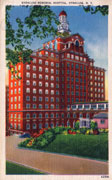 (lecture occurred May 20, 2007, presented by Steven Bedford) (lecture occurred May 20, 2007, presented by Steven Bedford)
What do Syracuse's Crouse Hospital and the Jefferson Memorial in Washington, DC have in common? The answer: an architectural legacy in the work of designer John Russell Pope (1874-1937). Today, some may dismiss Pope's architecture as conservative classicism, simply an architect copying antique forms instead of probing unexplored design territory. However the recognizable majesty of his famous buildings, like the National Gallery of Art and the National Archives, both on the Mall in Washington, make him a figure worthy of study.
That has been the life work of Steven Bedford, an architect and also an adjunct professor in architectural history at Rensselaer Polytechnic Institute in Troy, New York. Bedford has written several articles on Pope as well as authoring two books on the man, the most recent entitled, John Russell Pope: Architect of Empire . On May 20 at 2:00 pm, Bedford presented an illustrated lecture on Pope and his work at the Onondaga Historical Association Museum in downtown Syracuse.
Skirmishing Sites: The Boisterous Saga of Building Onondaga County's Courthouses
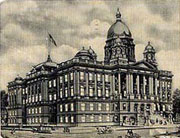 (lecture occurred April 29, 2007) (lecture occurred April 29, 2007)
Onondaga Historical Association Museum & Research Center curator of history Dennis Connors presented an illustrated lecture on Sunday, April 29 at 2 p.m. in the OHA Museum auditorium that traced the intriguing story of the community's efforts in the 19th and early 20th centuries to secure an adequate and appropriately imposing courthouse for the county. The Museum is located at 321 Montgomery Street in downtown Syracuse.
The program explored the various sites that were used over the decades to house Onondaga County government. The actual locations are directly reflective of the community's growth as the courthouse moved from locations influenced by turnpike construction, salt manufacturing, canal building and finally, the City Beautiful Movement of the early 20 th century.
Along the way, there were intense civic rivalries that had to be faced, conspiring land speculators, shrewd politicians, conniving salt boilers, and secretive arsonists. It is also the story of changing architectural styles, historic preservation battles and visionary citizens. Mr. Connors discussed some of the lesser-known stories of the courthouses, such as how the putrefying smells from cooking meals for incarcerated prisoners helped lead to the erection of one courthouse. He also touched upon plans to add historical interpretation to the current Columbus Circle Courthouse on the occasion of its 100th anniversary this year.
2007 CNY Community Reads "The Kite Runner" by Khaled Hosseini.
 (event occurred April 22, 2007) (event occurred April 22, 2007)
A riveting story of friendship, betrayal, atonement and finally forgiveness set in the backdrop of war torn Afghanistan. Linda Wiehl, Liverpool School District Global Studies Teacher talked about the history, traditions and culture of Afghanistan with items brought back from her trip to Afghanistan. The afternoon ended with a dramatization of Aghan folk tales by OHA's drama troupe.
Springs, Lakes & Reservoirs - The History of Syracuse's Water System
(event occurred March 11, 2007 at OHA Museum auditorium)
 Onondaga Historical Association curator of history Dennis Connors will present an illustrated lecture on Sunday, March 11 at 2 p.m. in the OHA Museum auditorium that will trace the intriguing story of Syracuse 's efforts in the 19 th century to secure an adequate and healthy water system. The Museum is located at 321 Montgomery Street in downtown Syracuse . Onondaga Historical Association curator of history Dennis Connors will present an illustrated lecture on Sunday, March 11 at 2 p.m. in the OHA Museum auditorium that will trace the intriguing story of Syracuse 's efforts in the 19 th century to secure an adequate and healthy water system. The Museum is located at 321 Montgomery Street in downtown Syracuse .
 The program will explore some of the various early sources tapped by the citizens of Syracuse before eventually setting their sights on the clear waters of Skaneateles Lake . And the decision to use Skaneateles was not easily transformed into reality, as there was opposition from mill operators who worried about the impact of lower water levels in the Lake and Skaneateles Creek. There was the struggle with the old private water company over acquisition of the existing distribution system. And then there was the engineering challenge of constructing an underground conduit system nearly 20 miles over rough terrain. There was even controversy over the massive construction of the new Woodland Reservoir with charges, tinged with racism, that contractors were importing African-American and Italian laborers from out-of-town who would work for less. The program will explore some of the various early sources tapped by the citizens of Syracuse before eventually setting their sights on the clear waters of Skaneateles Lake . And the decision to use Skaneateles was not easily transformed into reality, as there was opposition from mill operators who worried about the impact of lower water levels in the Lake and Skaneateles Creek. There was the struggle with the old private water company over acquisition of the existing distribution system. And then there was the engineering challenge of constructing an underground conduit system nearly 20 miles over rough terrain. There was even controversy over the massive construction of the new Woodland Reservoir with charges, tinged with racism, that contractors were importing African-American and Italian laborers from out-of-town who would work for less.
 The earliest sources for Syracuse water were often natural springs. But even the waters of Onondaga Creek were used for a time, although the high level of polluted effluents flowing into the Creek was a known fact. In addition to the health concerns, a major impetus for finding a better water source was the reoccurring problem in 19 th century Syracuse of enough municipal water to fight the roaring fires that regularly plagued downtown. The earliest sources for Syracuse water were often natural springs. But even the waters of Onondaga Creek were used for a time, although the high level of polluted effluents flowing into the Creek was a known fact. In addition to the health concerns, a major impetus for finding a better water source was the reoccurring problem in 19 th century Syracuse of enough municipal water to fight the roaring fires that regularly plagued downtown.
Syracuse China Rides the Rails
Syracuse China Rides the Rails!
(Event occurred Sunday, 10 December 2006)
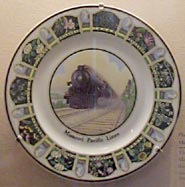 Dennis Connors, Curator of History at the Onondaga Historical Association Museum & Research Center (OHA) presented an illustrated lecture on December 10, 2006. Held at the OHA Museum, Connors' lecture explored the rich legacy of a local corporate institution, Syracuse China, as represented in its production of numerous patterns and designs for America's railroads. Dennis Connors, Curator of History at the Onondaga Historical Association Museum & Research Center (OHA) presented an illustrated lecture on December 10, 2006. Held at the OHA Museum, Connors' lecture explored the rich legacy of a local corporate institution, Syracuse China, as represented in its production of numerous patterns and designs for America's railroads.
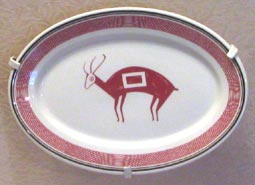 In the decades before jet airplanes and super highways, the primary mode of long distance travel for Americans was the nation's vast rail system, operated by numerous railroad lines. As these lines expanded, dining car service became essential. And as rivalry became fierce among the different railroads, elegant surroundings and memorable meals also became selling points for rail travel and a method for companies to create an image that was distinct from their competition. In the decades before jet airplanes and super highways, the primary mode of long distance travel for Americans was the nation's vast rail system, operated by numerous railroad lines. As these lines expanded, dining car service became essential. And as rivalry became fierce among the different railroads, elegant surroundings and memorable meals also became selling points for rail travel and a method for companies to create an image that was distinct from their competition.
The china place settings in the dining car were part of that distinctive image, especially in the hey-day of train travel from the 1920s through the 1940s. The Onondaga Pottery Company, the predecessor name for Syracuse China, was a major supplier to American rail lines. Their talented designers worked to create special space-saving shapes for dining car tables as well as distinctive patterns that conveyed the various lifestyles and regions associated with America's most famous trains. Connors discussed many of these special streamlined trains such as the New York Central's Mercury and the Milwaukee Road's Hiawatha . He also explained how these various trains and their dining car service reflected changing social patterns in the country.
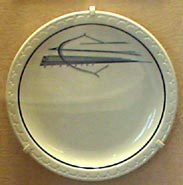 This lecture was offered in conjunction with the ongoing permanent exhibit at the OHA Museum entitled, Syracuse China: Fired Forms of the American Experience . This exhibit traces the history of Central New York's premier producer of dinnerware and how the design of that ware showcases much of America's social and economic movements over the last 130 years. This lecture was offered in conjunction with the ongoing permanent exhibit at the OHA Museum entitled, Syracuse China: Fired Forms of the American Experience . This exhibit traces the history of Central New York's premier producer of dinnerware and how the design of that ware showcases much of America's social and economic movements over the last 130 years.
The Onondaga Historical Association is a private, non-profit organization that operates both a public museum and research center on Montgomery Street in downtown Syracuse. The museum features two floors with seven different exhibition galleries focusing on Onondaga County and Syracuse history. For more information, call 428-1864 or visit the OHA web site at CNYhistory.org
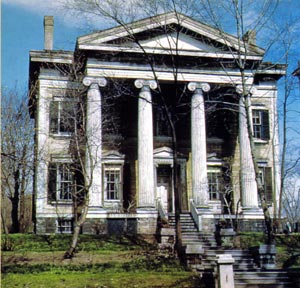 Mansion Memories - A Look at the Architectural Legacy of James St. : Mansion Memories - A Look at the Architectural Legacy of James St. :
(Event occurred Nov 19, 2006)
Dennis Connors, Curator of History at the Onondaga Historical Association Museum & Research Center, presented an illustrated lecture in the OHA Museum auditorium that traced the intriguing story of how James Street became Syracuse's most distinguished residential address in the 19 th century, only to lose its legacy of mansions during an excess of demolitions during the 1950s, 60s and 70s. The OHA Museum is located at 321 Montgomery Street in downtown Syracuse.
The program comprised of rare photographs of various mansions as Connors explained the development of the street, discussed some of the popular architectural styles of the 19th century and explored the interiors of a few examples. In several cases, he used before and after images to show what has replaced these elaborate villas, castles and estates. Some of the homes lecture attendees visited include Uarda , the great stone fortress of the Smith Family, the Sedgwick Cottage, once one of the city's best examples of the Gothic Revival style, and the former home of the Daniel Edwards family, owners of the city's famous department store that bore their name. Most American cities had boulevards of mansions like James Street. Some 19th century observers believed Syracuse's to be superior to many, because of its hillside topography and resulting vistas.
The presentation also explained how cultural changes in the 20th century led to decisions in the post World War II era that caused local officials to actually hasten the demolition of many of these homes. Mr. Connors has noted that many residents of the Syracuse community still remember the mansions as a point of pride and notoriety for Syracuse, and still mourn their loss, almost as a personal one, some 30 and 40 years later.
Illustrated Lecture: The Battle That Saved Washington, D.C.
(Event occurred Sunday October 8, 2006)
Dennis Connors, curator of history at the Onondaga Historical Association Museum & Research Center (OHA) presented an illustrated lecture at the OHA Museum that examined two of the lesser known battles of the Civil War: Monacacy and Fort Stevens.
Each occurred a few days apart during July of 1864, but both played a pivotal role in the outcome of the war. If but a few events had shifted slightly, the result would have been a Confederate flag flying over Washington City and Abraham Lincoln fleeing for his safety from the White House.
The second battle, at Washingtons Fort Stevens, involved a regiment of soldiers from Onondaga County, the 122 nd New York Volunteers, led by Colonel Augustus Dwight of Syracuse.
Those who attended the lecture learned of Robert E. Lee's desperate strategy in launching this final invasion of the North, led by the cantankerous Jubal Early. They also discovered how a disgraced Union general, who later wrote the classic novel Ben Hur , rose to this crisis and garnered the admiration and gratitude of Ulysses S. Grant, his former critic, even though he lost the Battle of Monacacy. Other characters in this tale include a former Vice-President of the United States, who found himself attacking the very city where he once served as president of the U.S. Senate; the citizens of Frederick, Maryland who wound up paying for 87 years on a loan that saved their town from being burned; and the Great Emancipator himself, Abraham Lincoln, whose actions at Ft. Stevens would make him the only U. S. President fired upon by enemy troops.
Before and after the lecture, patrons also had a chance to view the OHA Museums exhibit: Freedom Bound: The Story of Syracuse & the Underground Railroad. This gallery also functions as an object theater, which uses a sound and light show to re-create the actual 1855 journey of four fugitive slaves through Syracuse.
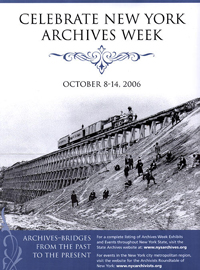 OHA's Research Center Celebrated New York Archives Week! OHA's Research Center Celebrated New York Archives Week!
Syracuse, NY - New York Archives Week is an annual observance of the importance of archival and historical records to our lives. Over the years, the State Archives, local governments, and other historical institutions in New York State have celebrated Archives Week in a variety of ways, ranging from small exhibits to formal banquets.
In an effort to make OHA's archival collections more accessible to first-time users, OHA's Research Center staff offered a free, informal presentation about using the research center, including an overview of its holdings during Archives Week.
So, if you're a genealogist investigating your family's history, a student working on a local history project, a film maker making the next promotional film on Syracuse, or anyone inbetween who wants to learn the ins and outs of OHA's Research Center, this indepth orientation was for you.
OHA's Research Center is open to the public during normal museum hours except Sundays and by appointment at other times. Archival collections are focused on Syracuse and Onondaga County history including families and individuals, business and industry, education, architecture, important events and much more.
Cultural Currents: The History of Arts & Cultural Activities in Syracuse
(Event occurred on April 12, 2006)
Dennis Connors, Curator of History at the Onondaga Historical Association Museum & Research Center, will present an illustrated program on Sunday, April 23 at 2 p.m. in the OHA Museum auditorium that will trace the intriguing story of Syracuse’s evolution in cultural activity. The Museum is located at 321 Montgomery Street in downtown Syracuse. The program will explore both the variety of venues that the city has used over the years as well as sample the types of lectures, performances, artists, cultural activity and amusements that local citizens flocked to see during the last two centuries.
Along the way, Mr. Connors will explain the location of the first true theater space in the city, reveal where one could find the “Phantasmagoria” show in the 1830s and review some of the top local artists of the 19th century. Those attending the lecture will “visit” the Alhambra, the Bastable and the Grand Opera House, all long lost performance spaces. A sampling of the great American architects drawn to produce commissions in Syracuse will be highlighted, including works by Alexander Jackson Davis, Minard Lefever and James Renwick. All of their buildings, unfortunately, were torn down by later Syracusans with shorter-term vision.
Mr. Connors will also include in his presentation information on the era in which Syracusans displayed their cultural achievements through a flurry of local monument building. And it will touch on some of the struggles to create museum facilities worthy of this community.
Tea & Sympathy: Women of the North Star Conspiracy
(Event occurred on Saturday, April 22, 2006
at 1PM)
Central New York Reads in Downtown Syracuse – do you? Meet a group of culturally diverse women from the 19th century for tea as they discuss their lives as written in the 2006 SU/CNY Reads community book choice, North Star Conspiracy by Miriam Grace Monfredo. Fresh, original and creative, this lively conversation brings together a cross section of women from Seneca Falls, NY in 1848 – a librarian, women’s rights activist, former slave, brothel keeper, plantation wife/slave owner and town cultural advocate—each with strong opinions that will reflect on the history of activism prior to the Civil War. The program discusses ideas and beliefs that will illuminate the past, converge with the present and offer hope for the future.
We encourage all participants that may be historically illiterate to become more familiar with past shakers and movers and their feelings about women’s rights, slavery, voting –even men—and to whet their appetites for more. Audience participation and opinions are welcome.
Cost is $5 per person and includes light refreshments. Door prizes include author signed copies of North Star Conspiracy.
Historic Bridges of Downtown Syracuse 
(Event occurred on Sunday, March 12, 2006 at 2:00 p.m)
Syracuse, N.Y. - Onondaga Historical Association Museum & Research Center, curator of history, Dennis Connors will present an illustrated lecture on at OHA’s Museum that will explore the intriguing history of bridges in downtown Syracuse. Syracuse is not thought of as having an impressive legacy of bridges such as a city like Pittsburgh, which is divided by two major American rivers. But although the scale is smaller, downtown Syracuse was crisscrossed with waterways for over a century. There was the Erie Canal, then the Oswego Canal and, of course, Onondaga Creek which still courses through the heart of the city. Over the years, turnpikes, streets, and railroads had to navigate across these waterways resulting in dozens of bridges throughout downtown. And in one locale, even the Erie Canal had to cross Onondaga Creek!
Most of these bridges have long been demolished, especially those related to the now filled-in canals. But a couple still remain which can be considered rare historic treasures. Three 19th century stone bridges still span Onondaga Creek in the heart of downtown. There also are the former DL&W Railroad bridges built in 1940 to elevate trains off Syracuse Streets. And not far to the west of downtown remains the last bridge in the city built to cross the Erie Canal. Those attending the lecture learned about these still-standing landmarks as well as some of the more famous bridges that have been lost, such as the various generations of Salina Street bridges that spanned the Erie Canal and the 1936 Art Deco giants of the New York Central railroad elevation. “The story of these bridges is a window into the forces that shaped the look, identity and economy of our community,” says Connors.
Entry to the OHA Museum is free, but a $5 admission ($4 for OHA members) for the lecture will be collected at the door to the auditorium.
A History Mystery: How A Rare 1775 Document Launching New York on the Road to Revolution Found its Way to Syracuse
(Event occurred on March 2, 2006 at 11:30 a.m.)
Everyone interested in National, State and Local History, please note: Syracuse University's Institute for Retired Professionals will meet on March 2 at 11:30 a.m. at the First Baptist Church of Syracuse, 5833 E. Seneca Turnpike, Jamesville. The topic: "A History Mystery: How A Rare 1775 Document Launching New York on the Road to Revolution Found its Way to Syracuse" with Dennis Connors, Curator at the Onondaga Historical Association. Guests are welcome. For details call 443-4846 or visit www.yeSU.syr.edu/irp
George N Barnard, CNY's Photographic Pioneer
Syracuse, N.Y. - Dennis J. Connors, Curator of History at the Onondaga Historical Association Museum will present an illustrated lecture on the intriguing life of a local 19th century photographer, George Barnard, whose iconic images of the Civil War have become famous. This illustrated presentation will take place at the Onondaga Historical Association Museum on Sunday, 29 January 2006 at 2 p.m. Admission for the lecture is $5 at the door, $3 for OHA members. The museum is located at 321 Montgomery St. in downtown Syracuse, NY.
George Barnard was born in 1819 and spent his formative years as a photographer producing daguerreotypes, an early technique for capturing images. He began this career in Central New York during the 1850s. Barnard worked both in Oswego and Syracuse and some of the earliest photographic images of those communities are his creations. He established a national reputation during the Civil War, however, while recording events and sites in both the Eastern and Western theaters of operation. His 1866 publication, Photographic Views of Sherman’s Campaign, is a rare collector’s item and documents the destructive nature of that famous March to the Sea.
After the Civil War, Barnard continued to work in the Charleston, South Carolina area, photographing plantations and other local life. Again, some of his views of African Americans laboring among the cotton fields have become national symbols of the southern economy that existed both before and after the war. Moving later to Chicago, he arrived in time to produce startling visual records of the destruction caused by that city’s Great Fire of 1871. Eventually, Barnard returned to Onondaga County to live out his retirement with family. He died in 1902 and is buried in the Town of Onondaga, along Pleasant Valley Road west of Cedarvale.
The Onondaga Historical Association Research Center has extensive research material on Barnard including a set of the prints produced in 1866 that document General Sherman’s Georgia campaign. OHA was also instrumental in having a stone placed in 1964 at his previously unmarked grave.
The History of Syracuse’s University Hill
(Event occurred on 17 March 2005)
Onondaga Historical Association, curator of history, Dennis Connors will present an illustrated lecture on Sunday, April 3, 2005 at 2 p.m. at the OHA Museum that will explore the development and evolution of the high ground just southeast of downtown Syracuse most known today as the site of Syracuse University. But this district also has an interesting history as a residential neighborhood, dating back to before the Civil War. The Hill also houses other sites with a rich heritage in the community, such as Thornden Park, the State School of Forestry and various hospitals. This program is being offered in response to Syracuse University Chancellor Cantor’s call for an exploration of the Soul of Syracuse. The university’s neighborhood reflects much Syracuse history, certainly a significant part of what defines the Salt City’s soul.
Those attending the lecture will learn about the two cemeteries on the Hill, see images of Yates Castle, view an early master plan for the campus, find out where golfers once roamed, explore some of the residential architecture that once surrounded the campus, and hear about the variety of hospitals that were established there. There will also be images of Marshall Street in the 1940s, maps of the campus in the 1890s, views of Memorial Hospital under construction and a demolition scene of “The Castle.”
Before and after the lecture, patrons will also have a chance to view the two floors of galleries at the OHA Museum, including the dynamic local story of the Underground Railroad presented in OHA’s Freedom Bound: Syracuse and the Underground Railroad exhibit. Admission to the OHA Museum is free, but a contribution of $3 ($2 for OHA members) is requested for the lecture.
The Civil War Correspondence Between a Rebel Sergeant and a Syracuse Abolitionist
(Event occurred on February 17, 2005)
The American Civil War marked the deepest division in our nation’s history. During this bloody conflict, over 500,000 Americans died because of fundamental disagreements about the nature of American society. In December of 1864, following more than three years of brutal combat and devastation, two men who had never met and were at extreme opposite positions in their view of the war, exchanged letters. Each tried to convince the other of the righteousness of their respective sides. One was Sidney E. Moseley, a sergeant in a Texas regiment from Austin who had been fighting on the Confederate side since the war began. The other was a Syracuse physician named Alfred Mercer who was an avowed abolitionist and Unionist.
How this unusual communication took place, what each wrote to the other and where the two letters are today will be discussed during a lecture at the Onondaga Historical Association Museum at 7 p.m. on February 17, 2005. This program is presented as part of the monthly meeting of the Onondaga County Civil War Roundtable and is free and open to the public. The lecturer will be the historical association’s curator of history, Dennis Connors.
About Events, Performances, Ghost Walk, Glorious Workplaces>, Walking Tours, Lectures |